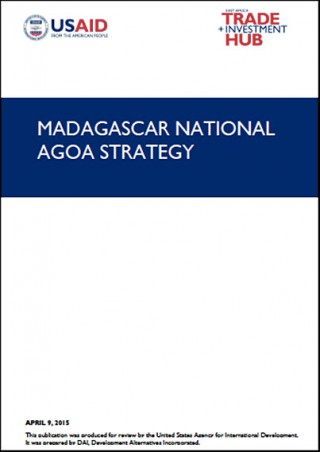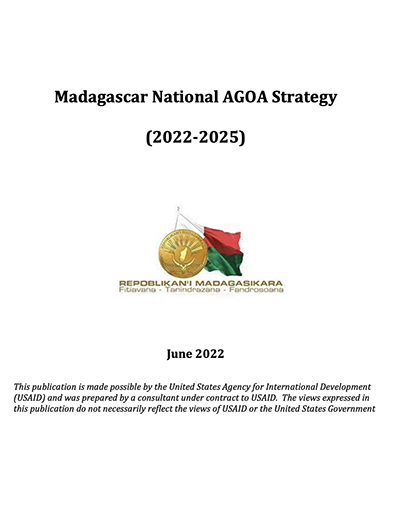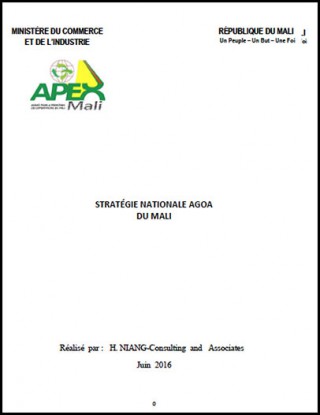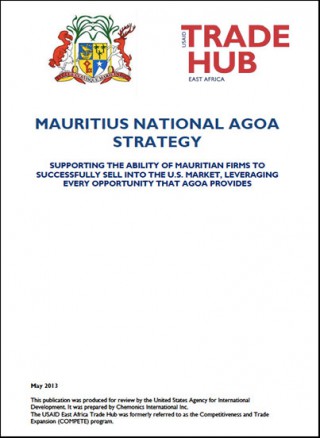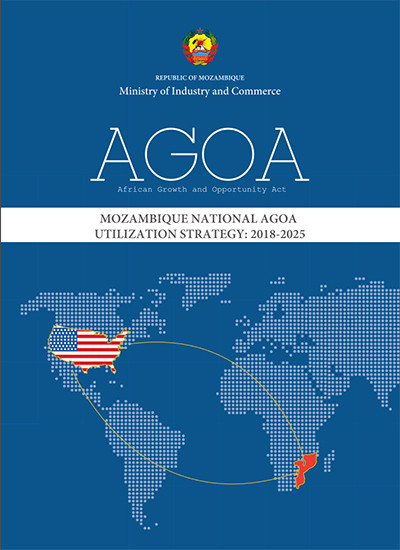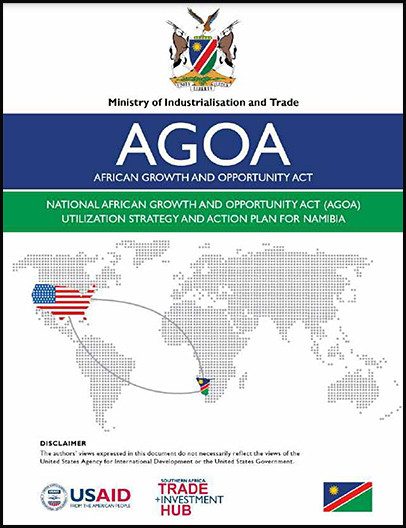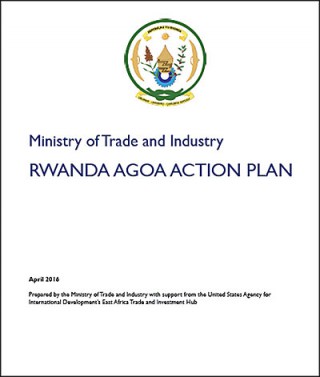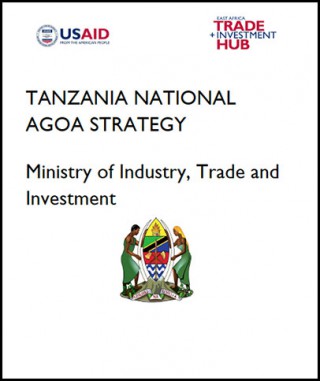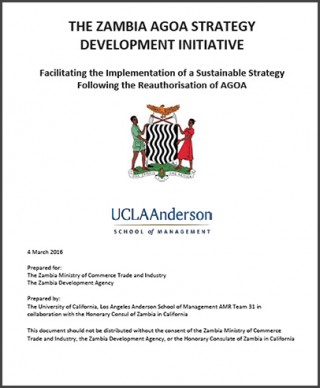National AGOA Strategies
Madagascar - National AGOA Strategy (new version below)
The objective of the AGOA strategy is to support the ability of Madagascar’s firms to successfully sell into the U.S. market, leveraging every opportunity that AGOA provides. AGOA has had a clear impact in stimulating Africa-U.S. trade. All exports, including energy-related products, from AGOA-eligible countries have grown over 300 percent, from $21.5 billion in 2000 to $86.1 billion in 2008. It has created more than 300,000 jobs, many of which are in the apparel sector, an industry that provides employment opportunities for women.
Madagascar - National AGOA Strategy 2022-2025
The new Madagascar National AGOA Strategy covers all aspects of analysis and design necessary for the formulation of a post-COVID plan and an update of the previous National AGOA Strategy. As such, the Strategy consists of two primary components. First is an assessment of the COVID-19 impact on Madagascar and AGOA-related sectors. Second is an update of Madagascar’s AGOA strategy, with the goal of developing a road map for the Government of Madagascar to maximize the benefits under AGOA and to implement this strategy to penetrate the U.S. market. The AGOA Strategy identifies the key gaps in private sector comprehension of the AGOA mechanism and U.S. market trends, and formulates plans to correct these deficiencies. The AGOA Strategy consists of a selection of sectors and products with the greatest market potential in the United States. When considering viability for the AGOA market, attention was given to regulatory requirements, standards and related certifications that are needed to enter the U.S. market and highlights the steps necessary for current and potential manufacturers to meet the relevant rules of origin and market-entry requirements. A review of lessons-learned from other countries that have successfully taken advantage of AGOA was also analyzed for benchmarking purposes. The AGOA Strategy looks at best practices and underscores key success factors to be considered and implemented. Finally, and most critically, the AGOA...
Madagascar - National AGOA Strategy 2022-2025 (french version)
La Stratégie nationale AGOA de Madagascar couvre tous les aspects d’analyse et de conception nécessaires à la formulation d’un plan post-COVID et à une mise à jour de la précédente Stratégie nationale AGOA. À ce titre, la Stratégie comporte deux composantes principales. L’analyse identifie les chocs de l’offre et de la demande dus à la pandémie ainsi que les politiques publiques mises en oeuvre à Madagascar et sur les marchés de destination affectant les opérations, la survie et la croissance des secteurs prioritaires de l’AGOA; évalue l’impact de la pandémie sur les perturbations de la chaîne de valeur, l’accès aux intrants, les changements dans les conditions du marché des consommateurs et d’autres facteurs qui affectent les opérations, la survie et la croissance des secteurs prioritaires de l’AGOA; et analyse le potentiel de diversification durable de la production à Madagascar, y compris vers les équipements de protection individuelle (EPI). La stratégie AGOA comprend une sélection de secteurs et de produits présentant le plus grand potentiel de marché aux États-Unis. Lors de l’examen de la viabilité au marché de l’AGOA, une attention particulière a été accordée aux exigences réglementaires, aux normes et aux certifications connexes nécessaires pour pénétrer le marché américain, ainsi qu'aux étapes nécessaires pour que les fabricants actuels et potentiels respectent les règles d’origine et...
Malawi - National AGOA Strategy
This document contains a National Response Strategy for Malawi for the African Growth and Opportunity Act (AGOA) trade preference program. This strategy provides a comprehensive plan for increasing exports from Malawi to the United States under the AGOA nonreciprocal unilateral trade preference program and attracting more U.S. investment into Malawi. Although a beneficiary country under AGOA since its inception in May 2000, Malawi has not significantly utilized the trade preference opportunities offered by the AGOA program. According to USITC Tariff Database, Malawi exports under AGOA (excl. GSP) were US$56.1 million in 2011, mainly consisting of tobacco, and the exports declined to US$46.3 in 2012 before peaking at US$57.4 in 2014. The sharpest decline since 2011 has so far been in 2015 when the AGOA exports went down to about US$41.0 million. However, AGOA exports from Malawi increased by 10% in 2016 to about US$44.9. Total AGOA and GSP exports followed the same trend. Malawi has exported mainly tobacco and limited amounts of macadamia nuts, cane sugar, textiles and apparel (garments) under the AGOA program. In addition, Malawi also exported lentils, basketwork, pigeon peas and household articles under GSP. This National AGOA Response Strategy for Malawi was developed in line with the recommendations of the AGOA Trade Preferences Extension Act of 2015 and is aligned with the objectives of the Malawi National Export Strategy (NES) 2013-2018.
Mali - National AGOA Strategy
La République du Mali est située au coeur de l’Afrique de l’Ouest. Avec une superficie de 1.241.238 km2, c’est un pays continental, qui partage environ 7.000 kilomètres avec 7 pays voisins. Les principaux ports d’approvisionnement du pays sont : Dakar (à 1 400 km environ de Bamako), Abidjan (à 1 200 km), Nouakchott (à 1 600 km), Conakry (à 900 km), de Lomé et de Tema (à 1973 km). L’économie malienne est essentiellement agricole. L’Agriculture contribue pour environ 35 % au Produit intérieur brut et près de 70 % de la population vit en campagne. ...
Mauritius - National AGOA Strategy
The preferential market access granted to Mauritius and other African countries through the Africa Growth and Opportunity Act (AGOA) has played a critical role in spurring Mauritius’ exports with the U.S. The textiles and apparel sector grew annually at a steady rate of 5 percent since AGOA’s adoption and leading non-textile/ apparel exports grew annually at as much as 23 percent between 2001 and 2006 and an overall rate of 12 percent since 2001. In effect, AGOA has contributed to expand the apparel industry of Mauritius on a scale that the country would unlikely have achieved without preferential access to the U.S. market.
Mozambique - National AGOA Strategy
Currently Mozambique has a low level of trade with the U.S. relative to other trading partners. is Strategy is therefore designed to: a.) identify AGOA-eligible sectors and products which Mozambique could export or increase export to the U.S., b.) to provide guidance on increasing the awareness and expertise of AGOA among Mozambique’s relevant public and private stakeholders and c.) to elaborate a set of strategic actions into short-term, medium-term and long term that, if implemented, could help Mozambique to better utilize the AGOA and capitalize on the preferred access to the U.S. market. This strategy includes 21 recommendations on improving awareness of AGOA, competitiveness of specific sectors, and exploiting the benefits granted to goods made in Mozambique for the U.S. market. Each recommendation includes identification of implementing entities as well as a recommended timeframe. As readers will note, there are a range timeframes from immediate to long term for Mozambique to better utilize AGOA and grow exports.
Namibia - National AGOA Strategy
This report contains Namibia’s African Growth and Opportunity Act (AGOA) Utilization Strategy. The purpose of the strategy is to provide a comprehensive plan on how Namibia can increase its exports to the United States (U.S.) under the AGOA Preference Program. The AGOA Preference Program is a non-reciprocal unilateral trade arrangement that was established two decades ago in order to promote bilateral trade and investment between the U.S. and sub-Saharan African (SSA) countries. To that end, the Ministry of Industrialisation and Trade (MIT) of Namibia requested the USAID Southern Africa Trade and Investment Hub (USAID TradeHub) to facilitate the development of a National AGOA Utilization Strategy for Namibia. The strategy focuses on diversifying and increasing Namibia’s exports to the U.S. under AGOA. One of the reasons why Namibia has not taken advantage of the AGOA Preference Program more effectively is due to the lack of a National AGOA Utilization Strategy that would position some of the country’s industry sectors to enter and establish a market presence in the United States.
Rwanda - National AGOA Strategy
The Ministry of Trade and Industry is pleased to present the AGOA Action Plan for Rwanda, which was prepared thanks to the valuable support of the United States Agency for International Development, through the East Africa Trade and Investment Hub. The document, produced in close collaboration with the MINICOM, constitutes the road map that will allow Rwanda to harness the benefits brought about by the African Growth and Opportunity Act, recently extended until 2025. Most importantly, implementing the actions contained herein will enable Rwandan businesses to utilize the next nine years (until 2025) to become competitive and be able to sustain a position in the US market even after the end of AGOA.
Senegal - National AGOA Strategy
Senegal's AGOA Strategy
Sierra Leone - National AGOA Strategy
The African Growth and Opportunity Act (AGOA) is an initiative of the US Government that allows the entry of many products from low income countries into the US Market duty-free. AGOA provides an opportunity for Sierra Leone products to enter the US market without the payment of duty. In order to benefit from this initiative, the Government requested help from the United Nations Economic Commission for Africa (AGOA) to design a strategy which, if implemented would enable the private sector to grow and increase exports to the US market. The International Growth Centre, Sierra Leone provided the technical support to undertake the exercise.
Tanzania - National AGOA Strategy
This strategy has identified four sectors that can be developed rapidly for the purpose of increasing Tanzanian participation in AGOA market access opportunities. First, the garments and textiles sector where harvesting low-hanging fruits in the garments subsector can generate the resources for subsequent investment in the textiles segment of the value chain. Second, the agro-processing sector, which includes horticultural products, spices and edible nuts, was also a natural choice. Third and fourth, the leather goods and footwear, and handicrafts sectors, respectively. Both are important in view of their potential for inclusion of rural communities, women and the youth in mainstream economic activities and should be revived. In addition to identifying the targeted sectors, this strategy also identifies issues and challenges as well as specific private sector needs in those areas and the kind of interventions required for effective implementation. There is only one goal—increasing Tanzanian exports to the U.S. under AGOA. I take this opportunity to assure my fellow Tanzanians of two things. First, the Ministry of Industry, Trade and Investment is committed to working closely with public and private sector stakeholders for the realization of the underlying goals and objectives of this strategy. Second, the strategy is aligned to the IIDS and will benefit from initiatives for its implementation.
Togo - AGOA Strategy
Operational action plan for the short and medium term use of AGOA
Zambia - National AGOA Strategy (updated version below)
The team identified four areas for consideration that would assist Zambia in implementing the AGOA strategy. Governance: Zambia would benefit from establishing an AGOA Steering Committee consisting of key stakeholders from specific private sector organisations, industry associations, and government agencies. Education and Outreach: Zambia should promote opportunities for educating businesses about AGOA. With that intent, a booklet was developed in collaboration with key stakeholders to educate Zambian businesses on the purpose and benefits of AGOA and provide guidance on the necessary steps to benefit under the trade act. An informational AGOA-Zambia website (www.agoazambia.com) provides comprehensive information about AGOA. For outreach, the team recommends that a roadshow be organised to establish credibility and promote Zambia as a viable commercial partner. Access to Financing: Zambia would benefit from connecting local businesses with agencies that provide financial resources to secure financing. Businesses can leverage available agencies such as the Citizens Economic Empowerment Commission (CEEC), Zambia Development Agency (ZDA), Industrial Development Corporation (IDC), and Overseas Private Investment Corporation (OPIC), a U.S.
Zambia - UPDATED National AGOA Strategy 2018-2025
This AGOA Response Strategy and Work Plan for Zambia has been prepared to assist policy makers and the private sector to take advantage of opportunities offered by the AGOA facility, while consolidating export capacities at the regional level.


